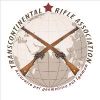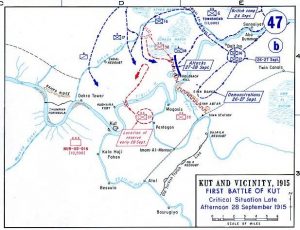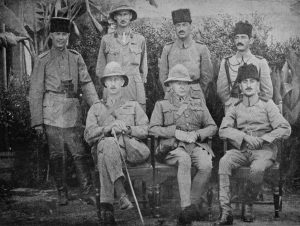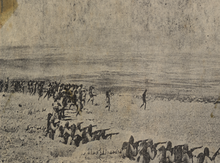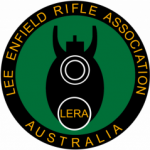THE KUT EL AMARA FRIENDSHIP SHOOT
This is a service rifle competition open to all shooters throughout the globe who have access to a 300 yard range and historic rifles.
TARGETS Fig 12 at 100 yds, then figure 11 at 200 and 300 yds. In the case of such targets being illegal, a blank target of the same size may be used with a central bull with dimensions shown below (see SCORING paragraph)
SCORING Fig 12: 5 for hits within the 30 cm circle (11.8 inches), remainder 4. Figure 11: 5 for hits within the 30 cm circle, remainder 4.
AMMUNITION A minimum of 54 rounds are required to complete the match. Competitors are to supply their own ammunition.
FIRING POSITIONS Prone, sitting, kneeling and standing. Shooters with disabilities / injuries who have difficulty with a particular position can agree a compromise position with the shoot RO, as long as the compromise position does not provide an advantage. For example: can’t kneel – shoot standing. If difficult getting down in time, be allowed to start in the final position (ie start prone, rather than go to prone from standing alert) – BUT shooter to only aim when other shooters are in position.
GLOBAL Historic Service Rifle league – Definitions
SR (a) – Service Rifle Class A : A service rifle as issued by any government prior to 1952 and used without any unauthorised alterations or additions.
Sling: an as issued 1937 pattern sling attached to the butt swivel and the upper band swivel. The sling may be used for steadying the rifle and may be placed round one arm and/or wrist but not round any other part of the body. For Veteran Optic Class only, the US M1907 Pattern sling is permitted and may be used either as a two point using the central sling swivel or with its integral loop. Rests: Classic, Veteran and All Comers: no artificial rests/support may be used other than the sling. Veteran Optic: a sandbag will be provided to support the forward hand/wrist in the prone position only. There must be no contact whatsoever between the rifle and the sandbag or the ground. Gloves: no padded shooting gloves are allowed. Shooting jackets: no shooting jackets are permitted. Back sight: a back sight as issued must be used. The wind gauge, if any, must be set centrally. Foresight: a blade foresight, which may be undercut. Wind: Classic, Veteran and All-comers (Iron): must be allowed for by aiming off. Veteran Optic and All-comers (Optic): windage sight adjustments are permitted. Sights: may be blackened, but nothing may be affixed for shading them. Trigger pull: minimum of 4.5lbs.
Kut El Amara
Practise 1 – 300x Mesopotamian Harassing Fire (with bayonets) Distance 300 yards Position Prone Rounds 2 sighters, then 10 to count Target Fig 11 on screen (or equivalent) Scoring Shots in 30 cm circle score 5, hits elsewhere on target score 4 HPS 50 Procedure: 1. From prone, fire 2 sighting shots with bayonets fixed in 2 mins; spotting discs shown for 30 seconds. 2. Remain prone and make ready with 10 rounds. 3. After the command ‘Watch and shoot’, the target will appear for 45 seconds, fire 10 rounds.
Practise 2 – 300x Agony Snaps Distance 300 yards Position Prone Rounds 10 to count Target Fig 12 or equivalent Scoring Hits inside inner ring score 5, then 4 and 3. HPS 50 Procedure: 1. In the prone position, make ready with 10 rounds. Wait for command ‘Watch and shoot’. 2. Fig 12 target will make 10 appearances of 3 seconds each at varying intervals over a maximum 5 minutes 3. Fire one shot at each appearance.
Practise 3 – 300x Guessing The Double Tap Distance 300 yards Position Sitting Rounds 10 to count Targets Hand-held Fig 11, Fig 12 and Figure 12c (or equivalent) Scoring Fig 11: hits in 30 cm circle score 5, hits elsewhere score 4; Fig 12: hits in inner ring score 5, elsewhere 4; Fig 12c: hits in outer ring score 5, elsewhere 4. HPS 50 Procedure: 1. In sitting position, make ready with 10 rounds. 2. After the command ‘Watch and shoot’, targets will randomly make 5 appearances of 6 seconds each – fire 2 rounds at each exposure. Target type and away times will be entirely at the discretion of the butts officer – BUT the sequence must be the same for each team.
Practise 4 – 500x The Kut Defence Distance 500 yards Position Prone Rounds 2 sighting shots and 10 to count Target Triple Fig 11s or equivalent Scoring 5 and 4 (5 for hits inside 30 cm ring on outer targets, 4 for hits elsewhere on outer targets; 0 for hits on centre target) HPS 50 Procedure: 1. Fire 2 sighters at any of the targets in 2 mins; spotting discs shown. 2. Stay prone and make ready with 10 rounds. Wait for command ‘Watch and shoot’. 3. Targets appear for 60 seconds, fire 5 rounds on the left target and 5 rounds on the right.
Practise 5 – 500x The Desert Snap Distance 500 yards Position Prone Rounds 10 to count Target Triple Fig 11s Scoring 5 and 4 (5 for hits inside 30 cm ring on outer targets, 4 for hits elsewhere on outer targets; 0 for hits on centre target) HPS 50 Procedure: 1. In the prone position, make ready with 10 rounds. 2. After the command ‘Watch and shoot’, the targets will make 5 appearances of 8 seconds per exposure, with away times between 10 to 20 seconds. At each exposure, fire 1 round at the left target and 1 round at the right target.
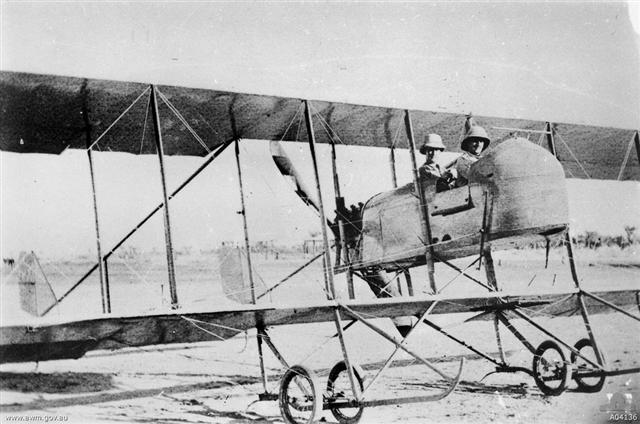
What is in a name?
Many competitions today use the name of a battle where glory was won or lost by our forefathers. Kut El Amara was chosen for this competition: it was a British-held Mesopotamian city besieged and seized by Turks in 1916. Here, the Australian Flying Corps suffered its first casualties and some of the men were taken prisoner. As per the vagaries of war, the British army later advanced and laid siege to now Turkish-held Kut El Amara. The Turkish defenders fought a long rear-guard action, moving slowly north for the remainder of the Great War. This denied Britain the decisive victory which would allow the army to serve where it was badly needed in France. Both sides fought bravely, with honour and respect. There were no recorded atrocities such as those encountered on the Western Front or in subsequent wars. This competition strives to reflect the friendship that has endured since the Great War between two once-belligerent nations, and to underline the futility of war and conflict. As an aside, our Bisley Butts Officer Mark Shaeffer‘s grandfather was at the battle of Kut and helped take Baghdad in 1918
